Silicates: Topaz
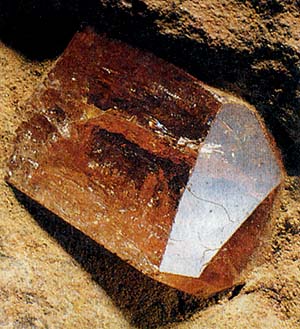 Diagnostic card.
Diagnostic card.
On the picture. Two different crystallographic types of topaz
Al 2 Fe 2 SiO 4
Diamond orthogonality
Hardness 8
Specific weight 3.49-3.6
Cleavage is perfect
Cracked shell
Color is colorless, differently colored
Color in powder white
Glitter glass
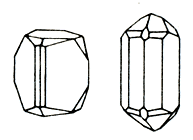
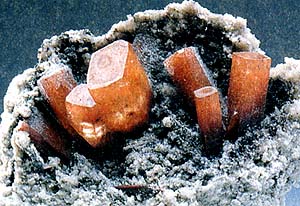 Before the topazes were called all the golden brown stones. The name originated from the ancient name of the island of Zeberget - Topaz. Topaz is usually not bright, most often they are golden yellow with a pink tinge. The most popular are pink topaz.
Before the topazes were called all the golden brown stones. The name originated from the ancient name of the island of Zeberget - Topaz. Topaz is usually not bright, most often they are golden yellow with a pink tinge. The most popular are pink topaz.
Under the influence of sunlight, the color of the stone pales and gradually disappears. The color of blue topaz is more stable. Often in topaz there is a sectorial distribution of color: in one crystal alternate blue and pink pyramids of growth. Due to perfect cleavage, topaz should not be scratched to determine hardness. It requires very careful handling when grinding and placing in a frame. Topaz is also sensitive to the effects of sulfuric acid.
Very large and heavy crystals of topaz are found in nature: in 1965, a topaz weighing over 100 kg was found in Ukraine. In Washington, at the Smithsonian Institution, a faceted topaz is stored in several thousand carats.
When grinding colored topaz is used most often step cut or cut with wedges, for colorless differences, the optimal cut is brilliant. Stones contaminated with inclusions are polished by cabochon.
Topaz is one of the hardest minerals: it scratches quartz and is scraped with corundum. The mineral is heavy, brittle, and has perfect cleavage parallel to the base. Transparent, glitter glass. In nature it is often found in the form of well-formed crystals of a short-prismic appearance with typical vertical shading on the faces. The color is variable, due to the presence of impurities of iron and chromium oxides.
Chemical composition - content (in%): A2O3 - 48.2-62; SiO2-28.2-39; F is 13-20.4; H2O to 2.45; Admixtures of iron, chromium, magnesium, titanium, and vanadium are noted. Singonia - rhombic, rhombo-dipyramidal kind of symmetry. Cleavage is perfect by (001), not clear by (101) and (011). Colorless, white, light blue, yellowish, wine-yellow, pink; The zoning of the color is characteristic.
Diagnostic signs.
Topaz can not be affected by acids (except sulfuric), refractory. In some of its differences, the color may disappear under the influence of sunlight or heat; In others, heating, on the contrary, enhances the reddish-brown tone. Topaz is the only natural gem that has the same specific gravity with diamond.
Topazes are similar in appearance to many minerals, such as apatite, aquamarine, beryl, brazilianite, chrysoberyl, citrine, tourmaline, and sometimes even diamond. The famous colorless topaz "Braganca" weighing 1640 carat, decorating the crown of Portugal, for a long time was considered a diamond. Additional difficulties in the diagnosis of topaz occur when the stones are artificially colored by heating. Yellow topaz becomes pink, blue or colorless. Unlike the imitations coming to the market - citrine or burnt amethysts that have acquired a golden color, which are called gold or Madeira-topaz - the true natural topaz is called noble topaz.
Origin.
This is a typical mineral of pegmatite-pneumatolite genesis, which is formed in small voids and veins of rocks of granite type.
Place of Birth.
The richest deposits are located in Brazil on the territory of the state of Mi-us-Gerais and the regions Te-omilo-Ottoni and Cerro. Other major topaz deposits are in Pakistan, Ukraine, the Urals, Mexico, Sri Lanka, Madagascar and Nigeria. In Italy, small colorless and pink crystals are found on the island of Elba and quartz porphyries of Guasso al Monte (province of Varese).
Primary deposits of topaz are confined to pegmatites and greisens, secondary deposits to placers. In the XVIII century. To the known topaz deposits in Europe belonged to Schnekkenstein in the Saxon Ore Mountains (now declared a natural monument). Today, the most significant topaz deposits are in Brazil (Minas Gerais, Espirito Santo), Sri Lanka, Burma and the CIS (Ural, Transbaikalia, Ukraine). Topaz is also found in Australia, Japan, Madagascar, Mexico, Nigeria, Zimbabwe, Namibia and the USA. Light blue topaz is known in Northern Ireland. Scotland, England (Cornwall).
Use in jewelry.
Topaz - one of the most common and popular jewelry stones. Since ancient times, it faithfully serves a noble purpose - pleases us with its beauty. For topaz, the most commonly used cut is a classic oval, very favorable for revealing the play of light. Mixed cuts, such as a rectangular plate and steps, are also used. Less common cut in cabochon, which is used for opaque topaz. Very beautiful look so-called polychrome stones, in which one part can be blue, and the other - wine.
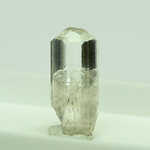
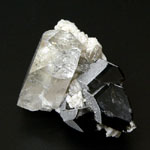
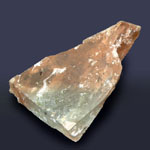

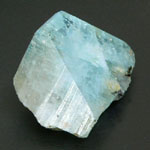
- Ghetchellit - "New Almaden blend" - arsenide and antimony sulfide (modern sulfosol)
- Antimony is a toxic metal (semimetal) , widely used in metallurgy, medicine and engineering
- Zirconium - a rare and undiscovered metal and the most dangerous precious stone in oxide and salt
- Gold - yellow dangerous and poisonous metal of modern accurate digital and cable technologies
- Sulfur is a golden-yellow toxic substance and a sign of active volcanic activity
- Cadmium is an undisputed toxic silvery metal unknown to a wide range of people
- Lead - a poisonous gray imitator of metallic silver and toxic metal blende
- Arsenic is a classic poison of medieval and modern poisoners and medicine in medicine
Poisonous and radioactive dangerous stones and minerals
** - poisonous stones and minerals (mandatory check in the chemical laboratory + explicit indication of toxicity)
** - radioactive stones and minerals (mandatory check on the standard dosimeter + ban on open sales in case of radioactivity exceeding 24 milli / g / h + additional measures of population protection)
Catalog of minerals and semi-precious stones of the world by groups
** - poisonous stones and minerals
** - radioactive stones and minerals


Comments
Commenting on, remember that the content and tone of your message can hurt the feelings of real people, show respect and tolerance to your interlocutors even if you do not share their opinion, your behavior in the conditions of freedom of expression and anonymity provided by the Internet, changes Not only virtual, but also the real world. All comments are hidden from the index, spam is controlled.